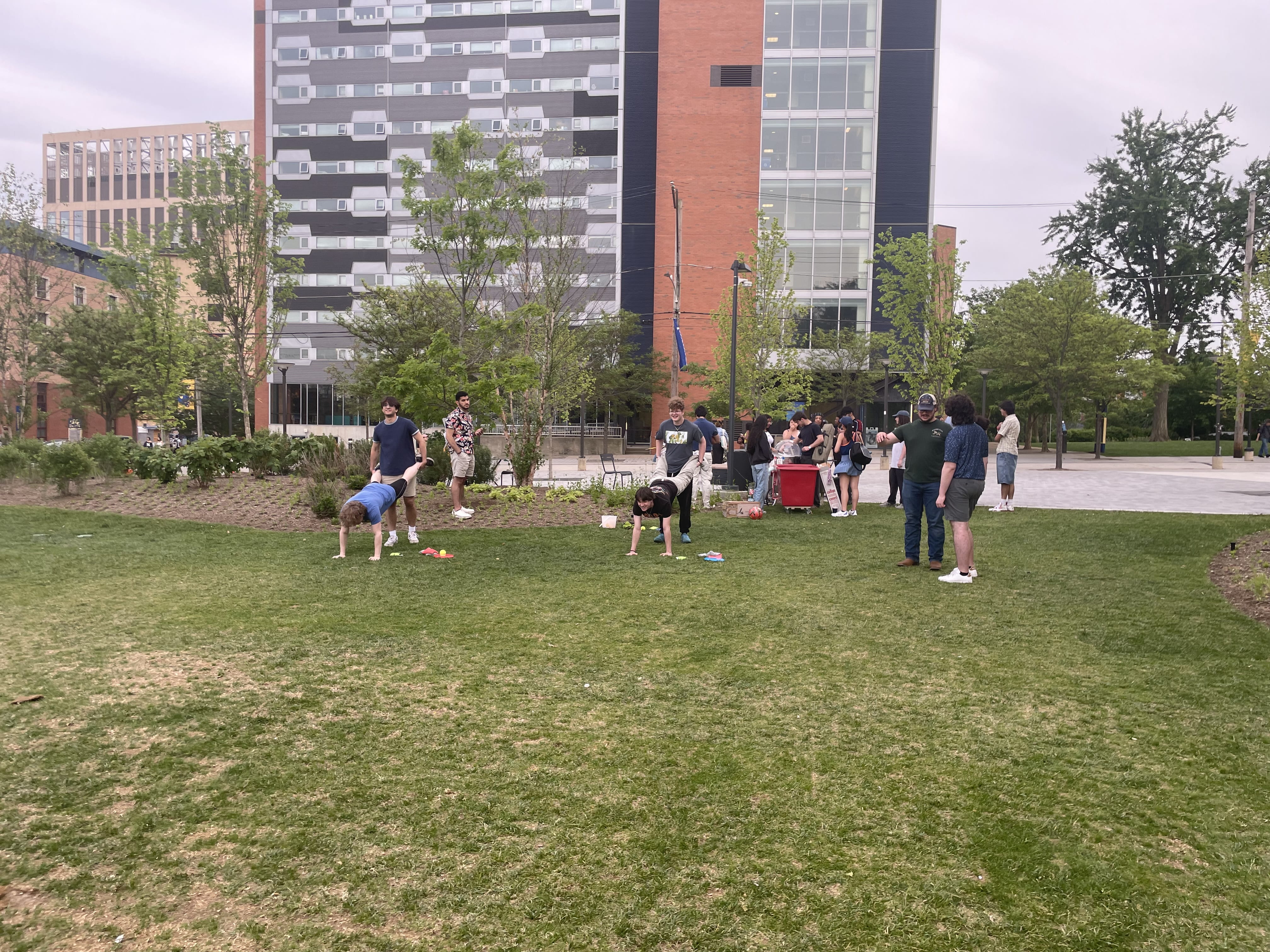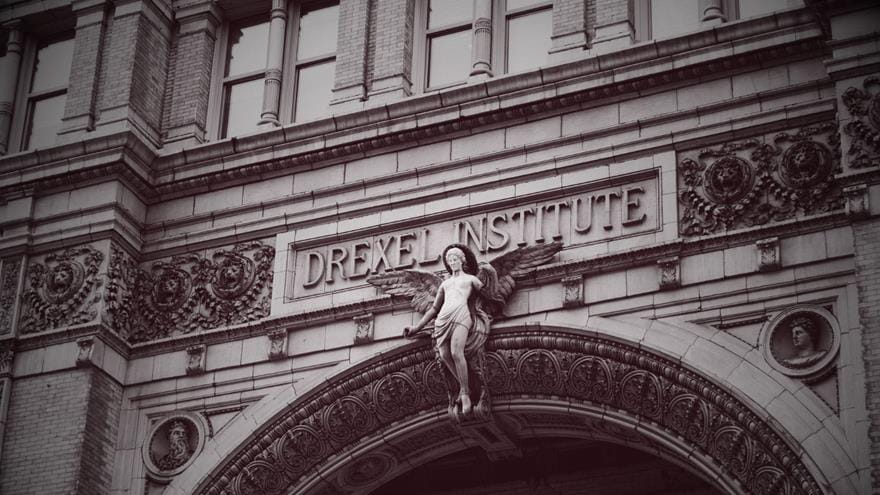Drexel Lawn At One Year

Students compete at Telly Challenge Day. Photo courtesy of Gwen Twiford.
At Drexel University, there may no longer be students living on the space at Race and 33rd streets, but memories are still being made where Myers Hall once stood on the University City Campus. In November 2024, Drexel Lawn (sometimes informally called Myers Green) opened as a “front lawn for students,” capping off a construction process that began in 2018.
In the year that it’s been open to students, Drexel Lawn has quickly become a go-to space for studying, sports, sunshine and more. Students from all around campus, residents from nearby neighborhoods and especially students living in nearby residence halls like Towers, Kelly, North and Race have incorporated it into their daily routines.
“I come out here and study a lot,” said Gwen Twiford, finance ’26 from the Bennett S. LeBow College of Business, who’s a resident assistant in Race Hall this year. "I'm the type of person who's so busy and always stuck inside, so whenever I can, I come sit out here and study or read a book. My residents will see me and come sit with me, so we get to hang out together. It’s great for an impromptu hangout as well.”
Nuri Ferguson chemistry ’26 from the College of Arts and Sciences, a resident assistant in Towers Hall, also uses the Lawn for a space to hang out, study and work, as well as watch friends play sports. Lots of students come out to kick around a soccer ball or put up volleyball nets, which sparks connections across campus.
“It builds a community more, and makes you feel like campus is lively,” Ferguson said. “A lot of people were disappointed when Buckley Field was closed, but it brought back some excitement when this new green space was announced, because there wouldn’t be a total loss.”
Ferguson and Twiford have both used the space for more organized hangouts with their residents, setting up picnics, a carnival, a fashion show and even a field day between Towers and Kelly halls, affectionately called Telly Challenge Day. They hosted tug-of-war, puzzles and other classic field day games. Though Twiford is an RA at a different hall this year, she wants to bring it back. The carnival, Ferguson said, featured a popcorn machine and lots of games to bring residents out of their rooms and into the community.
“I know tons of RAs that use the space in different ways,” Twiford said. “Even in the winter, people come out and have snowball fights, like during the first snowfall last year. It’s cool to see the space being used in fun ways all year round.”

Students like Ferguson and Twiford, who were at Drexel back when the Lawn was still the unoccupied Myers Hall, have watched the space go from an empty building to a cordoned-off construction site and finally saw the fences come down and the new space open up.
“I remember wondering what it was going to turn into,” Twiford said. “Last year, I was in Towers, and I could watch the construction from my window. Ever since it opened, the Lawn has felt like the most comfortable spot, not just on campus, but in Philly in general. You’re surrounded by buildings all the time, so I love being able to sit here in an open space.”
Now that it’s open, the Lawn is usually in use, both by Drexel students and by the West Philly community at large.
“I remember when it opened, I had never seen so many people on campus in one spot in my life,” Ferguson said. “Since then, it’s gotten much more commonplace to see people here. I think it’s a big proponent of community and bringing people together because if you see people from your window, you’ll think, ‘Maybe I should go outside too.’”
Twiford used to get questions from residents asking where they could go to be outside. Being inside all the time takes a toll, and with Drexel’s fast pace, it can be hard to find time to relax.
“It really gives you a break,” Twiford said. “It takes you away from being focused around academic buildings all the time. It feels like a good break to refresh and focus on your work in a different, outside setting.”
With so much student excitement over the Lawn, maintaining it requires a difficult balance, said Director of Grounds Scott Dunham. The grounds team has to work with the academic calendar, which doesn’t really line up with the growing calendar — it’s not ideal to ask students to keep off a busy lawn during the beginning of fall quarter, which is when the grass would have the best chance of bouncing back. Drexel Lawn is actually four times the size of the nearby Race Lawn, so Dunham and the grounds team knew it would be used heavily and have seen students take to the space in droves.
“We try to get whatever we can to grow over the summer, but honestly, it’s just a little too warm. Sometimes the soil temps are too high, or the birds eat the seeds, and by the time it wants to grow, everybody’s here and it gets trampled,” Dunham said. “Established lawns like Race Lawn can handle the foot traffic, but this area is still establishing itself. We know the space will continue to be heavily used as recreational space, so our challenge will be to keep it green for as much of the year as we can.”
Beyond just the turf, all of the plants and trees receive a lot of care throughout all seasons. There are more than 100 trees around the Lawn, and all plants are native, with thousands of little plants growing around different beds. In keeping with Drexel’s organic turf management model, which eliminates petroleum-based fertilizers and chemical-based weed control, the Lawn is maintained with hand-pulling weeds and using poultry byproducts as fertilizers.
In the fall, much of campus turns to yellows and oranges, thanks to the locust, oak, maple and redbud trees that you see on Drexel Lawn. Smaller plants include serviceberry bushes, asters and other small bushes.
“We try to keep a lot of the same species throughout campus so you see some continuity,” Dunham said. “We lost nearly all of the existing maple and locust around the former Myers Hall during construction, so when given the chance to plant 100 new trees, we wanted to pick from a variety of native species found elsewhere on campus that offered four-season interest. Everything was planted with the intent to have spring, summer and fall flowers, so the Lawn looks its best year-round.”
In This Article
Drexel News is produced by
University Marketing and Communications.

